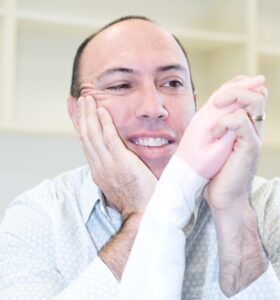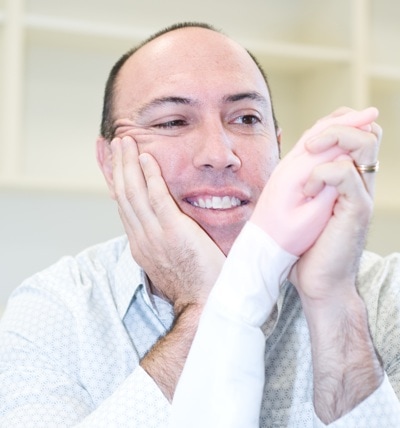I reckon the rubber hand illusion is a great way to provide hard evidence that the brain produces our sensations according to the availability of credible information, not just according to sensory input from the body. I use the rubber hand illusion to do this, but i think there is a version of the rubber hand illusion that might do it better. I have just reread a very interesting paper by Valeria Petkova and Henrik Ehrsson,[1] in which they did an interesting twist on the rubber hand illusion. They got participants to put both hands on the table, hid one hand from view and put a rubber hand in its place in the visual field. So – the participant looks down and sees a left hand and a right hand, but only the left hand is theirs, the right hand is a fake. The experimenters then stroked both of the hand the participant could see. This is different to the normal rubber hand illusion, which involves stroking the real hand that can’t be seen and the fake one that can.
In short, the study showed that about half of the participants could feel both hands being stroked. That is, stimulation of one hand led to the feeling of touch in both hands. This scenario has been shown in people after stroke[2] and we showed this almost a decade ago in people with complex regional pain syndrome, where the stimulus actually hurt,[3] but it has not been shown in healthy participants. There is a fairly strong argument to say that this illusion is because of multisensory processing of the stimulus – the visual input and the tactile input combine or are integrated, and the brain has credible information that there are actually two separate stimuli occurring, so it produces two separate tactile sensations. Think of how simple it would be to get a fake hand (actually the very realistic ones are not cheap – a few hundred dollars at least – but the joke-shop versions are pretty good) and set up the experiment these guys did and show a patient that what we feel in our body is because the brain has credible information that it is occurring.
We could, I guess, use the rubber hand illusion itself, but I think there is something that might be slightly more compelling in this version. Only 50% of people seem to get it, but it could be worth doing the conventional version first and then this one. It takes a couple of minutes. One could then repeat it with their eyes shut, when they won’t get an illusion and will only feel the stimulus on the touched hand, to show that it is ALL about credible information. You can also easily mess with the orientation of the rubber hand to show that as the information becomes less credible, the sensation becomes less likely. I reckon it is a lovely way to provide hard evidence to someone in pain that what they feel is all about credible information, not just sensory input from the body part concerned. Check out the paper to find out how they do it.
About Lorimer Moseley
 Lorimer is NHMRC Senior Research Fellow with twenty years clinical experience working with people in pain. After spending some time as a Nuffield Medical Research Fellow at Oxford University he returned to Australia in 2009 to take up an NHMRC Senior Research Fellowship at Neuroscience Research Australia (NeuRA). In 2011, he was appointed Professor of Clinical Neurosciences & the Inaugural Chair in Physiotherapy at the University of South Australia, Adelaide. He runs the Body in Mind research groups. He is the only Clinical Scientist to have knocked over a water tank tower in Outback Australia.
Lorimer is NHMRC Senior Research Fellow with twenty years clinical experience working with people in pain. After spending some time as a Nuffield Medical Research Fellow at Oxford University he returned to Australia in 2009 to take up an NHMRC Senior Research Fellowship at Neuroscience Research Australia (NeuRA). In 2011, he was appointed Professor of Clinical Neurosciences & the Inaugural Chair in Physiotherapy at the University of South Australia, Adelaide. He runs the Body in Mind research groups. He is the only Clinical Scientist to have knocked over a water tank tower in Outback Australia.
Link to Lorimer’s published research here. Downloadable PDFs here.
References
[1] Petkova VI, & Ehrsson HH (2009). When right feels left: referral of touch and ownership between the hands. PloS one, 4 (9) e6933.
[2] Sathian K (2000). Intermanual referral of sensation to anesthetic hands. Neurology, 54 (9), 1866-8 PMID: 10802803
[3] Accera NE & Moseley GL (2005) Dysynchiria: watching the mirror image of the unaffected limb elicits pain on the affected side. Neurology, 65 (5), 751-3. Downloadable PDF here.



